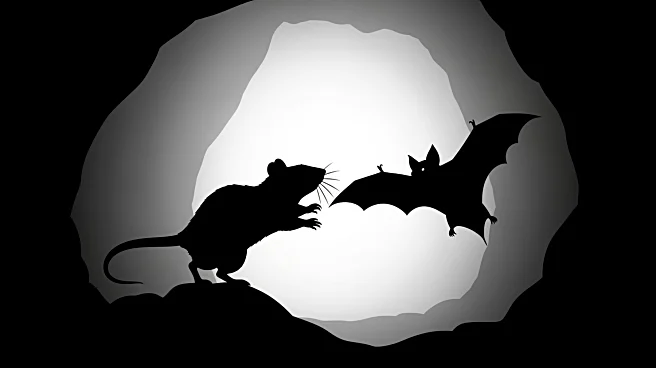What's Happening?
A recent study has uncovered a surprising interaction between rats and bats, where rats have been observed attacking and eating bats. This discovery was made by researchers who were initially studying
bat communication in northern Germany. The study, led by Mirjam Knörnschild from the Museum of Natural History in Berlin, found that rats, likely originating from nearby urban areas, were preying on bats in their natural habitats. This behavior was captured using infrared cameras in a cave near Bad Segeberg, Germany. The presence of rats in these areas is attributed to urban encroachment and the influx of tourists, which increases the rat population. The study suggests that this interaction could potentially serve as a new route for virus transmission, as rats could act as a bridging host for bat viruses, including coronaviruses, to humans.
Why It's Important?
The findings of this study are significant as they highlight a potential new pathway for the transmission of viruses from bats to humans via rats. Bats are known carriers of various viruses, including those related to the coronavirus family. The presence of rats in bat habitats, especially in urbanized areas, could increase the risk of these viruses being transmitted to humans. This is particularly concerning given the role of bats in the ecosystem, such as insect control and pollination, which are threatened by declining bat populations. The study underscores the need for effective conservation strategies to protect bat habitats and manage rat populations, thereby reducing the risk of future pandemics.
What's Next?
Following the study, researchers are collaborating with Umweltbundesamt, a German federal agency, to explore methods for safely reducing rat populations around bat hibernation sites. This initiative aims to mitigate the threat posed by rats to bats and potentially to human health. The research team plans to implement conservation actions that could help preserve bat populations and their ecological roles. Additionally, further studies may be conducted to understand the extent of rat-bat interactions in other regions and their implications for virus transmission.
Beyond the Headlines
The study raises broader questions about the impact of urbanization on wildlife and the unintended consequences of human activities on natural ecosystems. As cities expand, wildlife habitats are increasingly encroached upon, leading to new interactions between species that can have unforeseen effects on biodiversity and public health. The research highlights the importance of balancing urban development with ecological conservation to prevent such interactions and protect both wildlife and human populations.













